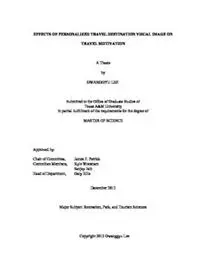Table Of ContentEFFECTS OF PERSONALIZED TRAVEL DESTINATION VISUAL IMAGE ON
TRAVEL MOTIVATION
A Thesis
by
GWANGGYU LEE
Submitted to the Office of Graduate Studies of
Texas A&M University
in partial fulfillment of the requirements for the degree of
MASTER OF SCIENCE
Approved by:
Chair of Committee, James F. Petrick
Committee Members, Kyle Woosnam
Sanjay Jain
Head of Department, Gary Ellis
December 2012
Major Subject: Recreation, Park, and Tourism Sciences
Copyright 2012 Gwanggyu Lee
ABSTRACT
This study examines the personalization of shown travel destination visual
images using professional photography upon travel motivations, feelings, and purchase
intentions of consumers in the online environment. The research design was
experimental and used data from a questionnaire via Qualtrics. A pilot test of the
instrument was conducted. The final questionnaire contained 25 items. A total of 194
questionnaires were collected and participants were randomly assigned to one of four
groups. Each group of 50 participants was exposed to a specific set of travel destination
visual images.
Further, several hypotheses related to the effects of personalization, professional
photography toward travel motivation, emotion, and purchase intention were tested. The
results indicated that: (1) travel motivation was affected by both personalization, and
professional photography of travel destination visual image; (2) personalization had an
influence on positive emotion, but professional photography did not; (3) it was expected
that personalization would act as a “push” factor on travel motivation, and professional
photography would influence the “pull” factor on travel motivation, but these two
hypotheses were not supported; (4) travel motivation and emotion positively affected
purchase intention, however this was only partially supported
Furthermore, the results of the present study implied that the “push – pull” travel
motivation theory was considered not entirely separate. Practical recommendations are
presented for online tourism marketers to enhance their service.
ii
DEDICATION
To my beloved family, Haelee and Chris.
I love you
iii
ACKNOWLEDGEMENTS
I would like to thank my committee chair, Dr. Petrick, and my committee
members, Dr. Woosnam, and Dr. Jain, for their guidance and support throughout the
course of this research.
Thanks also to my friends and colleagues and the department faculty and staff for
making my time at Texas A&M University a great experience.
Finally, thanks to my family and parents for their encouragement and patience.
iv
NOMENCLATURE
RPTS Recreation, Park and Tourism Sciences
TDVI Travel Destination Visual Image
v
TABLE OF CONTENTS
Page
ABSTRACT ...................................................................................................................... ii
DEDICATION .................................................................................................................. iii
ACKNOWLEDGEMENTS .............................................................................................. iv
NOMENCLATURE .......................................................................................................... v
TABLE OF CONTENTS ................................................................................................. vi
LIST OF FIGURES ........................................................................................................ viii
LIST OF TABLES ............................................................................................................ ix
CHAPTER I INTRODUCTION ....................................................................................... 1
Study Background ..................................................................................................... 1
Objectives of the Study ............................................................................................. 2
CHAPTER II LITERATURE REVIEW ........................................................................... 4
Effects of Visual Photography ................................................................................... 4
Personalized Experience ............................................................................................ 5
Travel Motivation....................................................................................................... 8
Proposed Hypothetical Model ................................................................................... 9
Summary .................................................................................................................. 10
CHAPTER III RESEARCH METHODOLOGY ............................................................ 12
Research Design ...................................................................................................... 12
Instrument Development ......................................................................................... 13
Procedures ................................................................................................................ 21
Sample Selection ..................................................................................................... 23
Data Analysis ........................................................................................................... 24
Presentation of Hypotheses ...................................................................................... 25
The Experimental Design ........................................................................................ 27
Manipulation Checks ............................................................................................... 28
Participants .............................................................................................................. 29
vi
CHAPTER IV FINDINGS .............................................................................................. 30
Introduction .............................................................................................................. 30
Descriptive Findings ................................................................................................ 30
Manipulation Checks ............................................................................................... 33
Development of Measurement ................................................................................. 37
CHAPTER V DISCUSSION AND CONCLUSION ...................................................... 50
Review of the Study Results .................................................................................... 50
Discussion ................................................................................................................ 53
Limitation and Future Studies ................................................................................. 55
Conclusions .............................................................................................................. 58
REFERENCES ................................................................................................................ 59
APPENDIX 1 REQUEST EMAIL .................................................................................. 70
APPENDIX 2 ONLINE QUESTIONNAIRE ................................................................. 71
vii
LIST OF FIGURES
Page
FIGURE 2-1. Hypothetical Model .................................................................................. 10
FIGURE 3-1. Adventure photography – professional and non-professional .................. 22
FIGURE 4-1. Least Square Mean of each treatment ....................................................... 39
viii
LIST OF TABLES
Page
TABLE 3-1 Motivational Items ..................................................................................... 16
TABLE 3-2 Experimental Design .................................................................................. 23
TABLE 3-3 Questions Assessing Manipulation during the Experimental Task ............ 29
TABLE 4-1 Demographic Characteristics of the Sample .............................................. 31
TABLE 4-2 Samples Assigned Two Groups per Treatments ........................................ 33
TABLE 4-3 Cell Means of Manipulation Questions ...................................................... 35
TABLE 4-4 Factor Analysis of the Personalization Dimension .................................... 36
TABLE 4-5 Factor Analysis of the Professional Photography Dimension .................... 36
TABLE 4-6 Factor Analysis of Travel Motivation Dimension ...................................... 38
TABLE 4–7 MANOVA of Travel Motivation ............................................................... 40
TABLE 4-8 Factor Analysis of Emotional Aspect Dimension ...................................... 42
TABLE 4-9 MANOVA of Emotional Factor ................................................................. 43
TABLE 4-10 Constructs of Motivation .......................................................................... 45
TABLE 4-11 ANOVA of Motivational Factors ............................................................. 47
TABLE 4-12 Regression Results ................................................................................... 48
TABLE 4-13 Summary of Hypotheses Results .............................................................. 49
ix
CHAPTER I
INTRODUCTION
Study Background
People live in a flood of information both online and offline. In particular, many
people are more exposed to advertisements online than from any other media. In May
2012, the average U.S. Internet user spent about 29 hours online, and the average
duration of viewing web pages was about one minute (Nielsen, 2012). This dramatic
growth in the use of the Internet has affected the tourism industry as well. Werthner and
Ricci (2004) found that tourism was ranked as the number one industry for online
transaction volume. Furthermore, the U.S. Travel Association (USTA) discovered that
the Internet was used by approximately 90 million American adults to plan travel during
2009 with 76% of online travelers planning leisure trips online (Fesenmaier, Cook &
Sheatsley, 2009).
While others surfing the Internet, they can easily see many travel advertisements,
which include texts, pictures and videos. However, some websites offer personalized
advertisements through which visitors can make a decision for a travel destination. As
the Internet has become a major factor in planning a trip, this research aims to
understand the influence of personalized travel destination visual images (PTDVI) on
intentions to travel.
1

